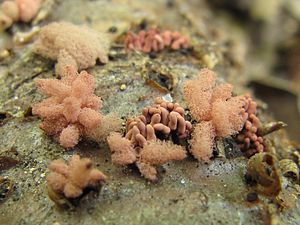Arcyria incarnata
| Arcyria incarnata | ||||||||||||
|---|---|---|---|---|---|---|---|---|---|---|---|---|

Arcyria incarnata |
||||||||||||
| Systematics | ||||||||||||
|
||||||||||||
| Scientific name | ||||||||||||
| Arcyria incarnata | ||||||||||||
| ( Pers. ) Pers. |
Arcyria incarnata , in German sometimes called Sienabrauner Kelchstäubling called, is a widespread and common slime mold from the family Trichiidae .
features
The fruiting bodies ( sporocarps ) are stalked to almost sessile and grow in tightly packed groups. The spore capsules (sporocarpies) are broadly ovate to cylindrical. When closed, the sporocarp is 0.5–2.5 mm high and 0.3–1.2 mm wide. After expansion of the hair braid ( capillitium ) they are up to 5 mm and 2.5 mm wide. They are light pink to flesh-colored, but shortly before ripe they are mostly tinged purple.
The membranous base ( hypothallus ) is common to the group. It is reddish in color and has a silvery sheen. It appears inconspicuous in transmitted light. The stalk is often greatly reduced and 0.1-0.5 mm long. It is pink to brown in color and has spore-like cysts that are 7–20 µm wide. The covering ( peridia ) quickly disappears in the upper area. The lower part remains as a flat cup. This appears almost colorless in the transmitted light. The inside has numerous warts, some of which are connected by irregular lines. The scalp is elastic and expands on all sides to about twice its size. The network formed from the fibers (elaters) consists of large meshes, is usually upright and matted. It has a few free ends that are somewhat thickened. It has only grown on the tip of the stem and is easily removable there. It is freshly tinted light pink, but later turns rusty brown. In transmitted light, the elaters appear colorless to light flesh-colored. They are ornamented with half-rings, rings and spirally arranged warts. The fibers measure 2.5–5 µm in diameter. The spores appear pink in mass, colorless in the transmitted light. They are covered with fine warts and clusters of larger warts. The spores measure 6–8, sometimes up to 9 µm in diameter.
The plasmodium is white. Before ripening, it is tinged gray-purple to pink.
Species delimitation
Arcyria incarnata is characterized by the light pink tinted, large-meshed capillitium that expands far in all directions. In A. insignis and A. minuta the scalp is firmly fused with the cup and is less elastic. A. affinis and A. major are more vividly colored and have a scalp that expands lengthways. Also A. stipata may be colored similarly. They have intertwined fructifications and a long lasting peridia. Microscopically, the scalp shows a clear spiral structure.
Ecology and diffusion
Arcyria incarnata grows on dead hardwood and coniferous wood. Branches lying on the ground are preferred. In the Alps it can reach a height of 2000 m above sea level. NHN are encountered. Associations were observed with Arcyria affinis , A. insignis , Comatricha nigra , Licea minima , L. testudinacea , Perichaena depressa , Physarum globuliferum , Physarum leucopus , Stemonitis axifera and Trichia persimilis . Common occurrences are common with Comatricha nigra . Arcyria incarnata can be found all year round.
The species is distributed worldwide and is found frequently in Central Europe.
swell
- Hermann Neubert , Wolfgang Nowotny , Karlheinz Baumann : The myxomycetes of Germany and the neighboring alpine region with special consideration of Austria . tape 1 . Karlheinz Baumann Verlag, Gomaringen 1993, ISBN 3-929822-00-8 .